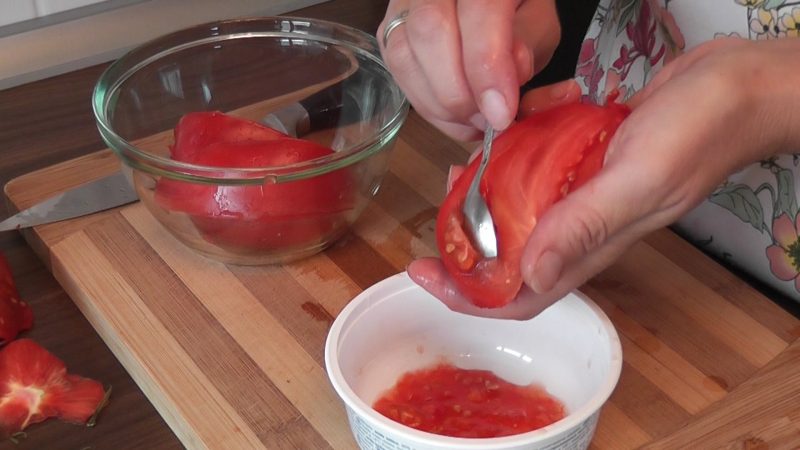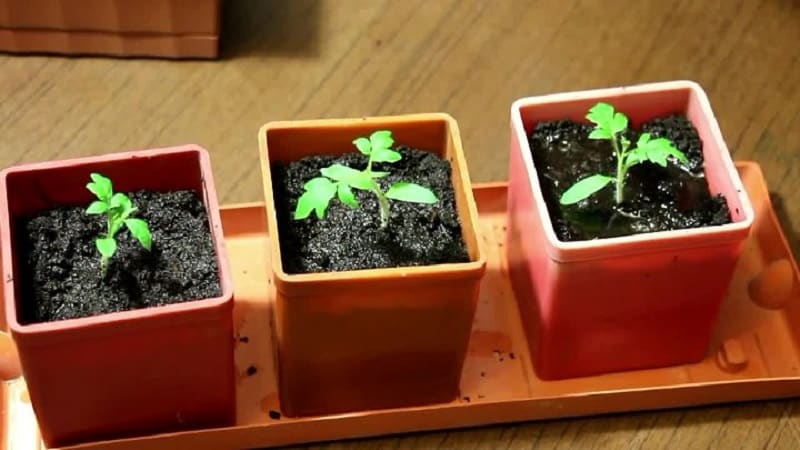How to prepare tomato seeds at home and get a winter harvest from them - advice from experienced gardeners
Experienced gardeners are thinking about how to prepare tomato seeds at home and no longer have to choose from many options from year to year. And if you have not yet experienced all the delights of a personal garden seed storage, try starting this season. Start with tomatoes.
Grow tomatoes from your own seeds on your windowsill and enjoy the taste of a fresh vegetable salad all year round. Tempting? Then let's move from words to action!
Advantages of self-collection of seed material
After a couple of unsuccessful attempts to grow a rich harvest that fully corresponds to the description on the seed package, experienced gardeners are increasingly wondering how to preserve tomato seeds at home.
On the one hand, this is confidence in the quality of the seed material, and on the other, saving money in the family budget. If you also want to experience the benefits of growing tomatoes at home, let’s continue our dive and look at all the intricacies of the seed selection process and the most common mistakes.
Choosing the best tomatoes
Everyone knows that only ripe, healthy fruits are suitable for collecting seeds. But here are some more useful tips that you may not have heard of yet:
- for open ground tomatoes we take fruits from the first cluster, and for greenhouse varieties - from the second and third;
- the fruits must correspond as closely as possible to the characteristics of the variety;
- rotten tomatoes will not work;
- we choose female fruits, they give a bountiful harvest, and year after year the quality of the variety improves.
How to distinguish male fruits from female ones
The tip of the male fetus has a point-shaped end, while in the female it is flatter and can even be in the form of a strip or speck. In cone-shaped and plum-shaped varieties of the Oxheart type, gender can be determined by the shape of the crown. In the male fetus it is more elongated.

Let's move on to collecting seeds
We cut the tomatoes into slices and carefully collect the liquid with seeds into a container made of glass, porcelain or food-grade plastic. In this case, the seeds must be completely covered with liquid. Cover loosely with a lid and leave at room temperature to ferment.
When the liquid is covered with a film and the seeds sink to the bottom, the fermentation process is complete. This may occur in 1-2 days depending on the variety and room temperature. After this, rinse the seeds with water and dry them on a paper towel. For final drying, disposable plates are suitable; it is convenient to collect the resulting seeds from them. Place clean seeds and leave for 5-7 days.
To prevent infection, seeds can be disinfected before drying. To do this, it is enough to place them in a weak potassium permanganate solution or laundry soap for 30 minutes. And then we move on to drying and storage.
Ideal conditions for storing collected seeds are a temperature of 0 to 5 degrees and a humidity of no more than 75%. But not everyone can create them. Therefore, we follow the main rule - to avoid changes in humidity and temperature.
A simplified method of harvesting tomato seeds
Collect tomato seeds along with juice in a glass container.And then, without additional fermentation and fermentation, spread it in a thin layer on a napkin and leave it to dry for 5-7 days. We collect the dried seeds and store them until planting.
Important! The fermentation method described in the first part of the article is more natural for tomato seeds and imitates the life cycle of the plant as much as possible. Tomato juice disinfects the seeds and helps get rid of bacteria that may accumulate on the tomato during the growing period.
Method with water without fermentation
We collect tomato seeds as described above. The presence and volume of juice in this case does not matter. Fill the container with the seeds to the top with water and leave for 15-20 minutes. During this time, stir the liquid 3-4 times so that the seeds are completely freed from pulp and juice. We wash and dry the seeds as in the first case.
If, with this method of collecting seeds, some seeds float, while others remain at the bottom - this doesn't mean anything. The top seeds are prevented from drowning by the pulp particles. Both seeds will germinate equally and can be used for planting.

Recommended timing for harvesting tomato seeds
In addition to the qualities of the fruits themselves, we also take into account the timing of seed collection. If you collect the seeds prematurely, the plant will develop worse. If you are late with selection, there is a risk of not getting a harvest at all due to possible infections and diseases.
The best option for collecting seeds is the middle of fruiting. They differ in different varieties and species:
- Early ripening varieties ripen in mid-July and finish bearing fruit in the second half of August. Collection can begin in early August.
- Mid-season varieties begin bearing fruit in August and end in early September. The optimal time for collecting seeds is the last week of August.
- Late-ripening varieties begin their maturity period in early September and end before October. This means we start collecting seeds on September 15th.
Selecting varieties for growing in an apartment
First of all, we choose which tomatoes can be grown on the windowsill. Popular varieties of tomatoes for open ground and greenhouses are completely unsuitable for balconies and window sills.
It is best to choose low- and medium-growing varieties of cherry tomatoes. Such tomatoes will ripen faster even with a lack of sunlight in winter. For information on how to grow tomatoes in a window at home, read the package of seeds; manufacturers indicate this information on the back.
If you already have seeds collected with your own hands and you have tried to grow tomatoes on a windowsill, great, use them and move on to planting.
Let's move on to landing
To grow tomatoes at home in winter, you need to start preparing in August by sowing seeds. First of all, let's prepare the necessary equipment. To grow tomatoes at home, ordinary plastic cups with holes in the bottom and 7-10 liter containers for further replanting are quite suitable.
To begin with, the seeds are germinated, this will speed up germination. Otherwise, you will have to wait too long for the fruits. First of all, place the selected seeds between layers of damp gauze.
As soon as the seeds hatch, they are ready to be planted in cups. To fill the glass, we use special peat tablets for growing seedlings. Place 1 seed in a glass and sprinkle with about 1 cm of substrate.
Feeding and hardening of seeds
To increase the yield of seeds, they can be feed nutrients. Choose any of the convenient methods:
- Aloe juice with water in a 1:1 ratio.
- Potassium or sodium humate - a quarter of a teaspoon per liter of water.
- Wood ash. a solution of 1 teaspoon of ash per liter of water.
- Special preparation “Immunocytophyte” or similar ones.
After preparing the selected option, the seeds are placed in a gauze bag and placed in a solution for 12 hours, then removed and dried, without rinsing with water.
Caring for seedlings on the windowsill
For watering, we use only water that has stood for at least a week; ordinary tap water will destroy your plants. For additional cleaning, you can use a filter, but this is no longer so important. We water ourselves once every 5 days, and we only moisten the soil; there is no need to spray the seedlings, this will only harm young tomatoes.
After the plant has the first 4 leaves, it can be replanted to a permanent location. To fill the pots, fertile black soil mixed with peat in a ratio of 3:1 or a ready-made soil mixture is suitable.
We place the pots with transplanted sprouts immediately on a well-lit windowsill with sufficient heat supply, or we organize additional lighting. If there is a radiator under the windowsill, cover it with a grill so that too hot air does not overheat the leaves of the plants. To ensure that the sun in the window evenly warms all parts of the plant, simply turn the pots in different directions. This way, your tomatoes on the window will not stretch too much towards the light source.
After about 7 days, you can carry out the first fertilizing with mineral fertilizers such as Mortar, Aquarin or Nitrophoska. Considering the fact that tomatoes are grown at home, fertilizing must be done at intervals of 10 days.

How to pollinate tomatoes at home
Of course, you won’t be able to pollinate tomatoes at home as efficiently as insects do, but it is very possible to create conditions as close as possible to this process. First of all, let's choose the right time. Since pollen ripens at night, pollination can begin at 8-10 am. At the first stage, the plant is sprayed to create the necessary humidity.
Then, using a fan, an imitation of wind is created. You can simply create a draft naturally, but make sure that it is not cold frosty air from the open balcony.
We carry out pollination at home using a simple soft painting brush. To do this, lightly touch all the opened flowers and transfer the pollen to the pistils. If after some time the flower petals bend back, it means that pollination was successful and the process of ovary growth has begun.
Read also:
How to use dill seeds for pancreatitis and why they are useful.
Features of growing gymnospermous pumpkin and what seeds you should pay attention to.
How to properly grow and when to collect beet seeds: step-by-step guide and important tips.
Additional lighting
To grow tomatoes at home on a windowsill, additional lighting may be required. And if your windows cannot boast a lot of sunlight, additional lighting will be simply irreplaceable.
Red and blue LED lamps are perfect for this. You can purchase them in specialized stores or online sites selling popular products.
Advantages of LED lamps:
- consume little electricity;
- do not heat up, which means they are more fireproof;
- environmentally friendly, because do not require special disposal.
Conclusion
The quality of vegetables in stores is becoming more and more questionable every year, and the desire to grow your own vegetables and herbs is only increasing. Don’t think twice about it, just try to do it at home or on your property.
If you follow simple rules and our advice, the result will not be long in coming. And this year you will enjoy the taste of excellent tomatoes grown in the window. And next year you won’t even have to buy seeds, because the best ones have already been selected for your personal seed collection.